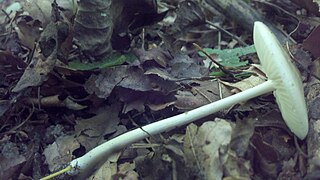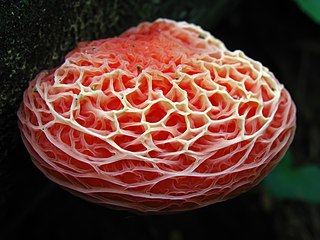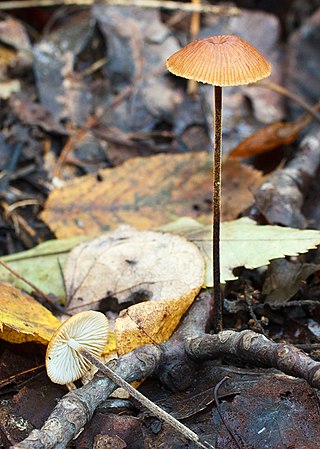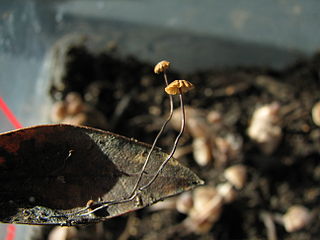
Arrhenia is a genus of fungi in the family Hygrophoraceae. Arrhenia also includes species formerly placed in the genera Leptoglossum and Phaeotellus and the lectotype species itself has an unusual growth form that would not normally be called agaricoid. All of the species grow in association with photosynthetic cryptogams such as mosses, including peat moss, and alga scums on decaying wood, and soil crusts consisting of mixes of such organisms. Typically the fruitbodies of Arrhenia species are grey to black or blackish brown, being pigmented by incrusting melanized pigments on the hyphae.

Xerula megalospora is a species of gilled mushroom in the family Physalacriaceae.

The Physalacriaceae are a family of fungi in the order Agaricales. Species in the family have a widespread distribution, ranging from the Arctic, (Rhizomarasmius), to the tropics, e.g. Gloiocephala, and from marine sites (Mycaureola) and fresh waters (Gloiocephala) to semiarid forests (Xerula).

Cyptotrama asprata, commonly known as the golden-scruffy collybia or spiny woodknight is a saprobic species of mushroom in the family Physalacriaceae. Widely distributed in tropical regions of the world, it is characterized by the bright orange to yellow cap that in young specimens is covered with tufts of fibrils resembling small spikes. This fungus has had a varied taxonomical history, having been placed in fourteen genera before finally settling in Cyptotrama. This species is differentiated from several other similar members of genus Cyptotrama by variations in cap color, and spore size and shape.

Rhodotus is a genus in the fungus family Physalacriaceae. There are two species in the genus with the best known, Rhodotus palmatus, called the netted rhodotus, the rosy veincap, or the wrinkled peach. This uncommon species has a circumboreal distribution, and has been collected in eastern North America, northern Africa, Europe, and Asia; declining populations in Europe have led to its appearance in over half of the European fungal Red Lists of threatened species. Typically found growing on the stumps and logs of rotting hardwoods, mature specimens may usually be identified by the pinkish color and the distinctive ridged and veined surface of their rubbery caps; variations in the color and quantity of light received during development lead to variations in the size, shape, and cap color of fruit bodies.

Rhizomarasmius is a genus of fungi in the family Physalacriaceae, containing about five species.

Cystolepiota is a genus of mushroom-forming fungi in the family Agaricaceae.

Pseudohiatula is a genus of fungi in the family Physalacriaceae. It was originally described as a subgenus of Mycena by the mycologist Rolf Singer before he moved to its own genus two years later. It was formerly thought to belong in the family Tricholomataceae, but a molecular phylogenetics study found it to be more closely The genus Cyptotrama in the Physalacriaceae. Rolf Singer had previously hypothesized these two genera to be closely related based on morphological features in 1986. It contains five species that are widely distributed in tropical areas.
Neoclitocybe is a genus of fungi in the family Tricholomataceae. The widespread genus contains 10 species that are especially prevalent in tropical regions.
Pseudohiatula cyatheae is a species of fungus in the family Physalacriaceae, and the type species of the genus Pseudohiatula. The species was first described by mycologist Rolf Singer in 1938.
Naiadolina is an agaric fungal genus that produces striking, yellowish fruit bodies on sedges in wetlands in eastern Canada. The lamellae are merulioid, forked and anastomosing. The type species was previously classified as a Marasmius in the Marasmiaceae, but phylogenetically, Naiadolina flavomerulina is in the Physalacriaceae sister to the genus Cryptomarasmius.

Cryptomarasmius is a genus of fungi in the family Physalacriaceae.
Cibaomyces is an agaric fungal genus found in China, Japan, France, and Germany in forests containing Fagaceae. It resembles Hymenopellis radicata because of its size, radiating stipe and glutinous cap. Unlike species in the genus Hymenopellis, Cibaomyces produces spiny basidiospores. DNA sequence data show it to be distinct from Dactylosporina, another spiny-spored genus in the Physalacriaceae.









